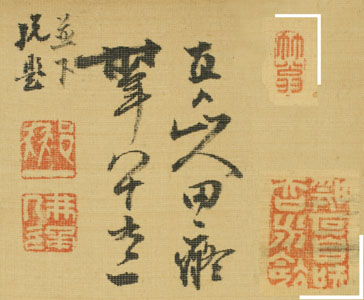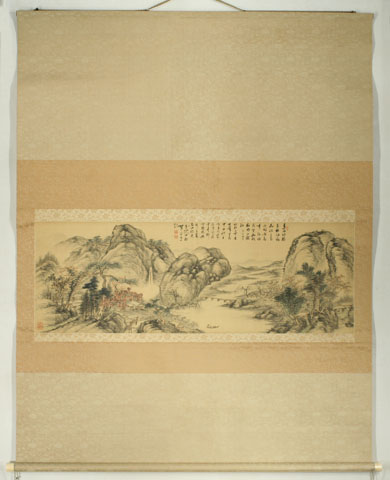Nanga
Horizantal landscapeSigned: Chokunyû sanjin Denchi .. nen hachijûyûichi (81)
Seals: Naichi, .. .. , Chikuô (tp), .. (bt)
Technique: colours on silk 37.3 x 107
Date: 1894, autumn 8th month
Mounting: ochre brocade and beige damask 154 x 119
Condition: a few tiny holes on the left, otherwise very good
遠林楓勝近林楓 / 陽水秋光☐不回 / 舟☐中☐回頭望 / 兩般紅飛一般紅
Seen from a distance the maple forest is more beautiful than seen from nearby.
The autumn sun plays upon the water.
In the boat people turn their heads to see:
The plain red becomes deep and clear.
Chokunyû was born in Ôita Takeda in Bungo province. His master Tanomura Chikuden (1777-1835) came from the same area. Chokunyû became his pupil when he was in his 9th year. Chikuden recognized his talents and adopted him, upon which Chokunyû gave up his own family name of Mitsumiya. Apart from his painting activities he also immersed himself in Chinese studies. He was, moreover, a pivotal figure in sencha-loving circles in Kyoto and Osaka. As the number of devotees augmented, he founded a sencha society in Osaka in order to preserve and consolidate the work of earlier sencha enthusiasts like Rai San’yô (1781-1832). It became known as the Seiwan Chakai, Blue Bay Tea Society. As its originator and promoter Chokunyû achieved tremendous fame. Early in the Meiji era he became involved in the founding of Kyoto’s Prefectural Art School and in due course became its first director. He also helped to establish the Japanese Nanga Society. He was a prolific artist not only drawn to landscape and flowers, trees and grasses, but also to birds, animals and human figures. With Tomioka Tessai (1836-1924) he was a leading figure in the sencha world of the Meiji era.
Reference:
Roberts p. 174
Araki pp. 1080-1081
Graham p. 171 ff.
Berry & Morioka ‘99 p. 92-95 (# 12)
Berry & Morioka ‘08 p. 303-05 (# 42-43, 79)
Price: ON REQUEST

